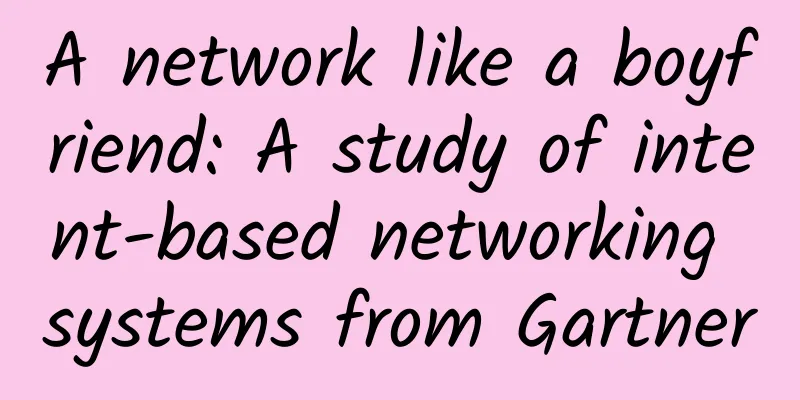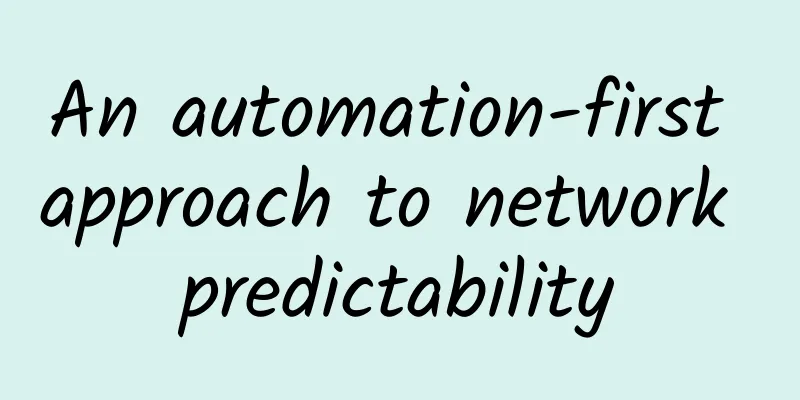A network like a boyfriend: A study of intent-based networking systems from Gartner

|
Intent-based networking is just getting started, but it could be the next big thing in networking because it promises to improve network availability and flexibility, playing a key role as organizations transition to digital business.
1. Overview 1. Key points
2. Recommendations I&O *** Planning, procuring, and managing network infrastructure should:
2. Strategic Planning Concept By 2020, more than 1,000 large enterprises will use intent-based networking systems in production, up from fewer than 15 today. 1. Definition A complete intent-based networking system provides four functions:
Ideally, an intent-based system is agnostic to vendors and network architectures. However, some vendors implement specialized intent-based solutions that work only with their own components. A complete intent-based networking system (IBNS) should include these four components. It should be noted that:
2. A new way to network IBNS is a radical departure from the way enterprise networks are managed today. Currently, conversions are manual and lack algorithmic validation. Furthermore, the percentage of automation for network changes is well below 26%. Furthermore, network reliability is also a highly manual process, while dynamic optimization of network infrastructure is rarely observed. 3. Description Intent-based networking systems can monitor, identify, and respond to changing network conditions in real time (see Figure 1). We expect intent-based networking systems to be delivered as software-based products that can be run on-premises or via SaaS. High-level business intent can be entered into IBNS directly through a portal or through third-party systems that leverage APIs to IBNS. IBN is a process that converts business intent into whether and how changes are made on the network. Before deployment, it generates the network and proves the "correctness" of the network configuration through algorithms. Next, if necessary, IBNS can make necessary changes to the underlying network. Meanwhile, throughout the process, IBNS obtains information about the network through multiple sources (such as monitoring systems) and constantly understands the current state of the network. Therefore, the system constantly compares the actual status of network operation with the expected state. If the network status is inconsistent with the original intention, IBNS can take corrective measures. Figure 1. How IBNS works 4. Network middleware vs Human middleware Essentially, IBNS provides network middleware to replace the intelligence that was previously available only from network engineer architects. Intent-based networking systems are driven by complex algorithms that translate business intent into network configuration. Algorithms are key to this process because they "capture knowledge efficiently and work at a speed and scale that humans cannot match." Therefore, IBNS differs from traditional design and implementation approaches because they do not rely entirely on senior network personnel, such as architects or engineers, to translate business requirements into high-level designs and detailed implementation plans. 3. Benefits and Uses Gartner believes that the biggest benefit of IBNS is improved network flexibility and availability, and support for unified intent and policy across multiple infrastructures. This is because IBNS generates the following configurations:
We believe that a full IBNS implementation can reduce network infrastructure delivery time by 50% to 90%, while reducing the number and duration of outages by at least 50%. In addition, IBNS provides several other specific benefits, including:
The concept of an intent-based networking system is abstract. Here is a practical example of how it can be implemented. 1. Example 1: Real-time application-centric WAN performance based on existing WAN In this case, the business requirements for branch applications are as follows:
These policies are fed into a UI that converts them into network policies. These policies are then configured on the organization's WAN infrastructure. At the same time, the organization's WAN edge infrastructure (routers, SD-WAN, WAN optimization controllers, etc.) sends diagnostic information (such as current network conditions and circuit status on branch devices) to the intent-based system. Therefore, the system will track the current status of the WAN path as well as application performance. The system can then continuously verify in real time that the policies/SLAs determined above are met. Due to network conditions, such as power outages, congestion, etc., if the above policies are not met, IBNS can take corrective actions, such as rerouting traffic, abandoning all entertainment traffic. 2. Example 2: Data Center Network - New Leaf/Spine Network In this scenario, the business requirements are:
The resulting technical requirements are:
Based on the technical strategy, the resulting Leaf/Spine configuration has a 3:1 oversubscription with N+2 spine switches. Equal-cost multipath (ECMP) routing will provide multipathing and failover. Each server is connected to two spine switches with sufficient links/bandwidth to carry all traffic in the event of a Leaf switch or network interface card failure. All server port access control lists comply with the required segmentation rules. The system will then generate a bill of materials, cabling guides, and device profiles for each device. Once implemented, IBNS will test the network to verify that it has been deployed correctly, and will then monitor continuously to ensure continued compliance with business policies. 3. Adoption rate We anticipate that it will be a practical move to tie the adoption of intent-based networking to a network refresh plan. Early rollouts may only apply to well-defined, specific use cases, such as Leaf/Spine data center structures or WAN edge infrastructure. Furthermore, we recommend enabling different intent subcomponents gradually. Similar to IBNS is IDS/IPS technology. In early IDS/IPS deployments, while traffic reduction is possible, most organizations start by implementing only detection capabilities and then gradually add prevention/blocking measures. Similarly, for early IBNS implementations, organizations can start by only verifying policy/intent. The next step may be human approval of the policy (and perhaps automation after approval), followed by long-term acceptance of some form of dynamic, automated self-remediation. We expect the number of commercial enterprise deployments to remain in the tens through the first half of 2017 and to be in the hundreds by mid-2018. By the end of 2019, we estimate that more than 1,000 enterprises will be using intent-based networking systems in production. 4. Why? For 15 years, IT vendors have been promising dynamic, self-configuring/self-optimizing infrastructure. However, for most enterprises, this promise has remained largely unfulfilled. That said, Gartner believes that intent-based networking systems will gain adoption in the next two to three years for the following reasons:
5. Arguments against adoption The contrarian view that intent-based networking will never reach mainstream adoption is based primarily on:
IV. Risks There are multiple risks associated with this technology, many of which are immature. As of Q1 2017, we estimate that fewer than 15 organizations worldwide have deployed a complete intent-based system in production. As such, it remains unproven. These factors could limit adoption and cause vendors to not continue to invest in solutions in the long term. Specific risk factors are described below. 1. Technical feasibility IBNS relies heavily on algorithms to understand enterprise networks as well as human intent. These algorithms have not been proven in a variety of enterprise network implementations or use cases. As a result, IBNS may not be able to address scaling issues across a variety of scenarios. 2. Suppliers are immature Many of today’s pure-play intent-based networking vendors are smaller startups that may lack the financial resources to sustain themselves in the market over the long term. 3. Risk avoidance Intent-based networking is radically different from traditional networking practices, requiring network personnel to “trust” machine-generated algorithms. However, the risk-averse culture ingrained in network teams promotes a preference for incremental changes that are deemed “safe.” As a result, IBNS may never be deemed secure enough to gain traction in the market. Furthermore, early implementations may fail, increasing avoidance of intent-based systems. 4. Intention Cleansing We expect to see significant "intent washing" just as we see cloud and SDN vendors looking for ways to create continued word-of-mouth about existing products. In this case, vendors sell products as intent without having the necessary functionality. As a result, enterprises invest in them but may not get the full benefits of IBNS. 5. Network Center IBNS is inherently focused on the networking domain. IBNS has limited (or no) awareness and control over storage and compute infrastructure, which are key components of application infrastructure. This may limit the value of IBNS and slow the adoption of the technology. However, intent-based server and storage systems may emerge in the next two to three years, perhaps applying transformation capabilities to dynamic optimization technologies. V. Evaluation Factors When evaluating vendors that provide intent-based networking capabilities, enterprises should consider the following criteria:
6. Technological Alternatives Intent is a new way to plan, design, implement, operate, and optimize networks, and there is no direct alternative that solves the problem in the same way. However, there are many alternatives that can provide some of the benefits of IBNS, including:
It should be noted that IBNS supports automation, orchestration, and SDN capabilities; therefore, these are also complementary technologies. Outside of the networking realm, there is a related technology known as dynamic optimization. Figure 2. Intent-based and alternative approaches VII. Representative Provider Several companies offer intent-based capabilities, ranging from complete systems to key components of intent. Over the next 18 months, we expect several vendors to enhance their offerings to address a wider range of IBNS capabilities. Here are a few relevant players in this space:
|
<<: If WiFi coverage is not good, should I use a wireless repeater or a powerline modem?
>>: Debunking three myths about edge computing
Recommend
818 Cloud Go: Tencent Cloud offers cloud servers starting from 74 yuan/year, 1C2G5M for three years starting from only 288 yuan
As June begins, all major online platforms have l...
UUUVPS: 60 yuan/month-1GB/30GB/4M/Hong Kong CN2 line
UUUVPS is now holding a three-year anniversary ev...
[Black Friday] Psychz Los Angeles server monthly payment starts at $15, E3 series monthly payment starts at $29
Psychz is a Chinese-owned data center that was fo...
Flutter hybrid project highway Pigeon
Earlier, we mentioned that Flutter uses BasicMess...
Understanding Ethernet Switching Technology in One Article
Labs Guide Currently, most campus networks are ne...
DotdotNetwork: $19/month - 2 cores, 16G memory, 30G SSD, 4TB/10Gbps bandwidth, Los Angeles data center
Recently, I received a submission from DotdotNetw...
ARP spoofing principle, never connect to free WIFI at will! ! !
1. Analysis of ARP attack principles 1. What is A...
Top 10 Web Trends: How to Stay Ahead in 2021
[[422976]] 【51CTO.com Quick Translation】 Due to t...
MoeCloud Anniversary: 30% off down payment for KVM on CN2 line in London/San Jose, 15% off permanently
MoeCloud is a Chinese VPS hosting company establi...
CloudCone Easter Sale: $14.28/year - 1GB/45GB/4TB/Los Angeles Data Center
CloudCone's Easter sale started today, offeri...
Will 5G be the next disruptive technology?
The telecommunications industry likes to use the ...
RhinoTech: Dedicated servers seckill + 20% off starting at $24.5, US/Japan/Korea data centers
RhinoTech sent an email yesterday about its Augus...
Huawei's ecosystem is expected to prosper exponentially in response to demand
【51CTO.com original article】 As we all know, in t...
Gartner: China's IT spending is expected to grow 7.7% in 2021
According to the latest forecast by Gartner, the ...
2021CHINC, to be continued! New products, new solutions, new values, we are different!
As an annual grand event for medical information ...









